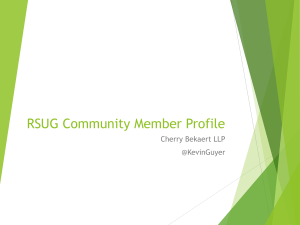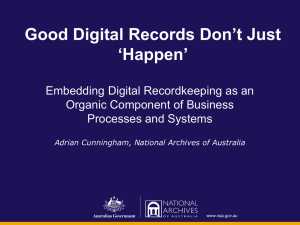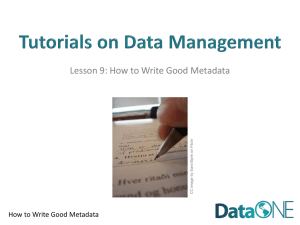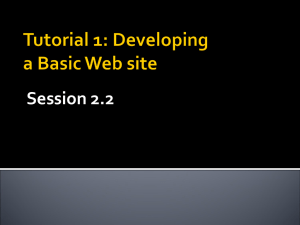Data Management - National Center for Ecological Analysis and
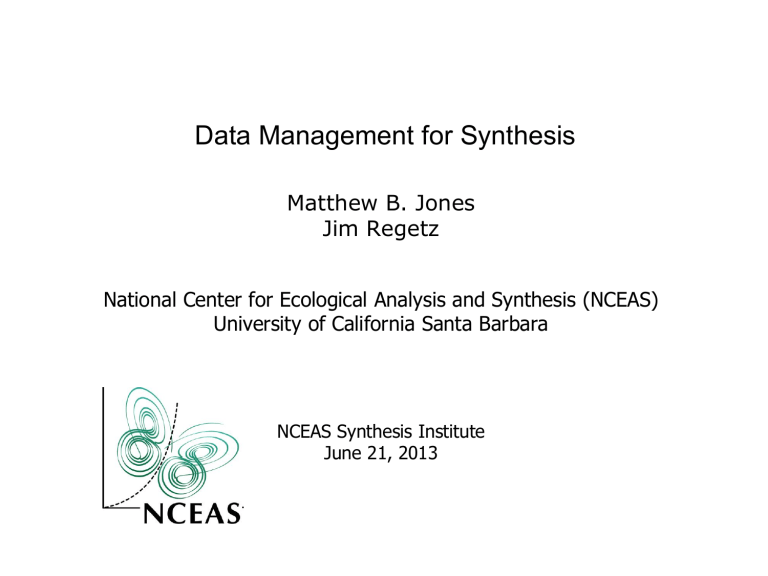
Data Management for Synthesis
Matthew B. Jones
Jim Regetz
National Center for Ecological Analysis and Synthesis (NCEAS)
University of California Santa Barbara
NCEAS Synthesis Institute
June 21, 2013
Fri 21 June Schedule
Data management, metadata, and data repositories
Readings: [https://projects.nceas.ucsb.edu/nceas/documents/88]
8:15-8:30
8:30- 9:15
9:15-10:15
3:00- 5:00
5:00- 5:15
(Disc) Feedback/thoughts on previous day
(Lect) Data Management
(Actv) Scientific data repositories: Data discovery and contribution
10:15-10:45 * Morpho Install and Break *
10:45-11:45 (Tutl) Documenting and Sharing data with Morpho
12:00- 1:00
1:00- 2:00
2:00- 2:45
2:45- 3:00
Lunch Social media with Jai and Jarrett in NCEAS lounge
GP: Data sharing policies
(Disc) Report and discussion: Data sharing policies *
* Break *
GP: Locating, organizing, documenting project data
"The view from the balcony" - []
2
Barriers to Synthesis
• Data not preserved
– Tiny proportion of ecological data are readily available
• Dispersed, isolated repositories
– Each community has its own; disconnected; underutilized
• Lack of software interoperability
– Metacat, DSpace, Mercury, iRODS, XMCat, OPeNDAP, ...
• Heterogeneous data
– Many data formats, metadata formats, and varying semantics
3
Dispersed data from field stations
Data diversity
• Biological
– e.g., Gene, Organism, Population, Species, Community, Biome,
Ecosystem
• Environmental
– e.g., Atmospheric, Chemical, Ecological, Hydrological,
Oceanographic, Physical
• Social
– e.g., Land use, human population
• Economic
– e.g., trade, ecosystem services, resource extraction
Biodiversity data heterogeneity
Space Time Taxa
“ Dark ” data in the long tail
Heidorn, P. 2008. doi:10.1353/lib.0.0036
From http://gbif.org
Software diversity
GMN
Data Heterogeneity
Low Heterogeneity High
High
• Tight coupling
• Simple subsetting
• Explicit semantics
Volume Low
• Loose coupling
• Hard subsetting
• Limited semantics
Solutions
• Preserve data
• Adopt standards
• Create networks
• Create interoperable software
PRESERVE DATA
Preserve data in the KNB
–
Diverse Contributors
–Individual investigators
–Field stations and networks
–Government agencies
–Non-profit partnerships
–Scientific Societies
–Synthesis centers
60
45
30
15
0
Data Types
• Ecological
• Environmental
• Demographic
• Social/Legal/Economic
Data
Sizes
%
MB
13
Knowledge Network for Biocomplexity
Data Distribution
Total: 25,191 data sets Data until: 07 Oct 2011
Metacat Data Server
• Data and metadata management
• Stores, search, and document data
• Customizable Web-based search interface
• Web metadata entry tool
• DOI Support
• Runs on Linux, Windows, MacOS
• Replication capabilities
• Postgres or Oracle backend
• OAI-PMH harvester
• GPL open source license
ADOPT STANDARDS
Metadata and data heterogeneity
• Every community has
– many data schemas
• one for each project and person
– many data formats
• ASCII, NetCDF, HDF, GeoTiff, ...
– many metadata schemas
• Biological Data Profile, Darwin Core, Dublin Core,
Ecological Metadata Language (EML), Open GIS schemas, ISO Schemas, ...
• Accepting this heterogeneity is critical
Metadata
Owner and Contact Metadata
Column metadata
Wizard to create metadata
Morpho
Morpho highlights
• Create metadata in EML format
• Manage data in EML packages
• Save, publish, and share data
• Search for data
• Multi-language
– English, Spanish, Chinese, French,
Portuguese, Japanese
• Export data and metadata
• Cross-platform, and open source
Morpho
Data Citation
• NCEAS can issue DOI identifiers for publicly archived data sets:
– doi://10.xxxx/AA/gulfwatch.9.15
• Always resolve to the data set
• Used in journals to cite data usage
CREATE NETWORKS
Global Metacat deployments
LTER Data Catalog
PPBio Data Catalog
A Federation of repositories
•
Diverse Federation == Resilience
– Failover for temporary outages
– Insurance against project/institutional failure
– Avoid correlated failures
•
Diverse Federation == Scalability
– Storage increases with Member Nodes
– Incremental costs to each MN to replicate
– Distributes sustainability costs
Creating Interoperability
•
Member Nodes (MNs)
– Heart of the federation
– Harness the power of local curation
•
Coordinating Nodes (CNs)
– Services to link Member Nodes
•
Investigator Toolkit (ITK)
– Tools for the whole data lifecycle
Interoperability
Member Nodes
• Authoritative members of the Federation
• Curate data holdings
–Provide unique identifiers for each object
–Ensure availability, quality, and reliability
• Replicate holdings for other MNs
• Provide access and access control
• Log and report accesses to objects
• Engage with DataONE community
• Deploy a DataONE-compatible software system
Avian
Knowledge
Network
Member Nodes
CREATE INTEROPERABLE
SOFTWARE
Kepler
Software Interoperability
Analyze
Plan
DMP-Tool
Collect
Integrate Assure
Discover
Preserve
Describe
Data &
Metadata (EML)
✔ Check for best practices
✔ Create metadata
✔ Connect to ONEShare
Member
Node
Data Flow and Replication
NODC USGS KNB
How do we harness the long tail?
• Efficient data federation
– Focus on individual contributors
• Late binding in informatics systems
– Loose coupling
– Schema-less storage
• Central search for discovery
• Interoperable software
Data Registration Activity
• http://knb.ecoinformatics.org/knb/cgi
-bin/register-dataset.cgi?cfg=knb
Questions?
• Contact:
– Matt Jones <jones@nceas.ucsb.edu>
– Jim Regetz <regetz@nceas.ucsb.edu>
• Links
– http://www.nceas.ucsb.edu/ecoinfo/
– http://knb.ecoinformatics.org/
– http://dataone.org



